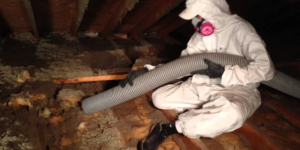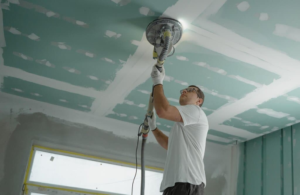Insulation Removal is a messy project that requires specialized equipment. Proper preparation minimizes hazards and makes the task more efficient.
Begin at the farthest corner of your attic, working back toward the access point. This ensures you don’t track insulation dust throughout the living space of your home. Cover furniture and other equipment with plastic sheeting. Click the https://www.perthinsulationremover.com.au/ to learn more.

Insulation can help regulate your home’s internal temperature, but it does have a limited lifespan. Over time, it can become compressed or settle, reducing its ability to properly regulate temperature. Additionally, pests can build nests or burrows within the insulation, causing it to lose structural integrity and creating unpleasant odors.
Replacing old insulation is a cost-effective way to make your home more comfortable and energy efficient. However, the process requires specialized equipment and can be a challenging DIY project for homeowners. A professional team will have the tools and knowledge necessary to complete a safe and timely job while following strict safety measures.
Before beginning the removal process, it’s important to prepare your space. Cover up walls and floors and block off access points to the attic. It’s also recommended to have a large dumpster on standby for the disposal of contaminated insulation. It’s also important to use proper equipment during this process, including a stud finder to identify wall studs and minimize damage. A utility knife, a vacuum cleaner with a special attachment for removing insulation and a pry bar will also be useful.
While the process of removing blown-in insulation is fairly straightforward, it’s still important to follow proper safety precautions. First, it’s essential to wear protective gear, including a respirator, goggles, and gloves. A high-powered vacuum is also necessary to effectively suck up loose insulation material. Lastly, it’s important to keep a containment area sealed so that dust and other contaminants don’t spread throughout the house.
When it comes to removing batt or roll insulation, it’s best to start at the farthest corner of the attic and work your way back toward the attic access door. This will ensure that you don’t disturb or damage other areas of the attic and will avoid unnecessary cleanup. Additionally, you’ll want to have a large garbage bag ready to place the rolled insulation in.
It’s also a good idea to use a tarp when working in crawl spaces to protect your floor and prevent any leakage from contaminating other parts of the home. When the removal is complete, it’s important to dispose of the contaminated insulation according to your local regulations. Some materials, such as asbestos and older fiberglass insulation, may require specialized handling and disposal procedures to ensure your safety. Hiring a professional to remove your old insulation ensures that these materials are handled appropriately to avoid hazardous exposure. This will protect you, your family, and your pets.
Removal
Insulation plays a key role in the comfort of your home and its energy efficiency. However, it is also often the host for mold spores and pests that can be harmful to your health and compromise the structural integrity of your home in some areas. Removing old insulation and replacing it with new will improve your indoor air quality and make your home more comfortable and healthy for you and your family.
The first step of any insulation removal process is to identify the type and condition of the existing insulation. This will dictate the tools and precautions needed to properly remove it.
For example, if your insulation is contaminated with mold or pests, special precautions and PPE will be necessary to avoid inhalation and skin irritation. In addition, the workspace must be sealed off to contain the work area and limit the spread of contaminants.
If your insulation is a loose-fill material, such as fiberglass batts or cellulose, a vacuum or scraper may be required to collect and dispose of the materials. This can be a messy and dangerous task that should be handled by professionals who have the equipment and experience to properly manage this process.
Foam insulation is another tricky material to deal with. It expands when it is cut and requires a utility knife or specialized foam saw to properly manage. It can be difficult to work with and creates a large amount of dust and debris that can pose serious health risks if not handled correctly.
Once all the necessary preparations are made, it is time to begin the actual insulation removal process. It is best to start in the furthest corner of the attic and work your way back toward the entrance, removing the insulation as you go. This will help to minimize tracking and maintain a systematic approach that will make the removal process faster and more efficient.
While you are in the attic, it is a good idea to inspect your roof and the structure of your home to determine if any repairs or replacements are necessary. This is the best opportunity to fix any water damage or other issues that might impact the effectiveness of your attic insulation and the overall safety and comfort of your home.
Once the insulation is removed, it is important to thoroughly clean up your workspace and tools. This includes removing waste bags, vacuum hoses and other equipment from the attic and cleaning up any surface coverings inside your home. This will ensure that any unhealthy particles are not transferred from the attic into your living space and vice versa. Additionally, it is a good idea to leave a dumpster outside your home for the disposal of the insulation waste. Most non-hazardous insulation can be disposed of with regular trash but if you have a large amount or specialized materials, it may be required to contact a company that handles construction debris for proper disposal options.
Disposal
Insulation removal can be a messy and time-consuming process. It’s important to have a plan for how to dispose of the old insulation and the materials that are removed. This helps to ensure that everything is handled efficiently and safely. It also helps to minimize any inconvenience for the property owners.
Some types of insulation require special disposal methods. This is because they are made from materials that can be harmful to the environment or to people if they are exposed to them. This is why it’s important to hire professional services that follow strict disposal guidelines and practices. This ensures that they will properly dispose of the materials and will not cause harm to the environment or anyone else.
Using proper equipment, tools and techniques is also crucial to the successful disposal of old insulation. For example, professionals use protective gear to avoid direct contact with the insulation material. This includes gloves and masks to prevent skin irritation or respiratory problems. In addition, they will make sure to use proper ventilation when removing and disposing of the insulation.
Local regulations may differ regarding how and where to dispose of old insulation. It’s important for professionals to stay up-to-date on these regulations so that they can ensure that the insulation is disposed of according to regulations. This can help to protect the environment and prevent legal issues for property owners.
Oftentimes, the materials used for old insulation can be recycled and reused to make new insulation. This is a great option for the environment as it reduces waste and saves resources. In addition, it can also save homeowners money on their energy costs. However, it is important to check with your local recycling facility before attempting to recycle any insulation materials.
In some cases, if the old insulation has been exposed to moisture or water, it can develop mold. This can be a health risk for you and your family, as it can lead to respiratory issues and damage the structural integrity of your home. If this occurs, it’s important to remove the moldy insulation as soon as possible.
Insulation can also be a breeding ground for pests, such as rodents and termites. Leaving old insulation in your home can allow pests to nest, which can compromise the structure of your home and lead to further health issues. Having the right type of insulation in your home will not only prevent pests, but it can also help with overall air quality by keeping allergens and pollutants out of the indoor space.
Whether you’re looking to install new insulation or simply replace your old one, a professional can provide a comprehensive service that includes inspection and evaluation of the attic space. They can identify the type of insulation that’s best for your home and recommend the appropriate installation methods. They can also address any concerns, such as mold and pests, before proceeding with the installation.
